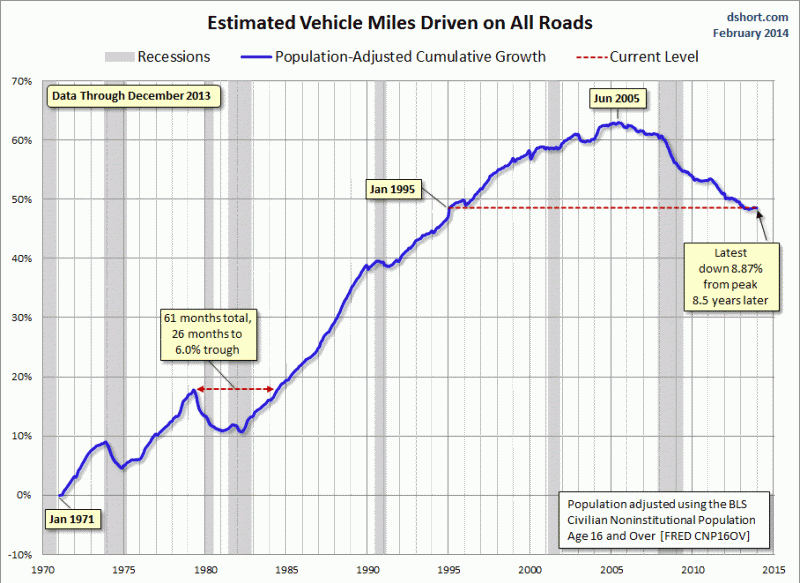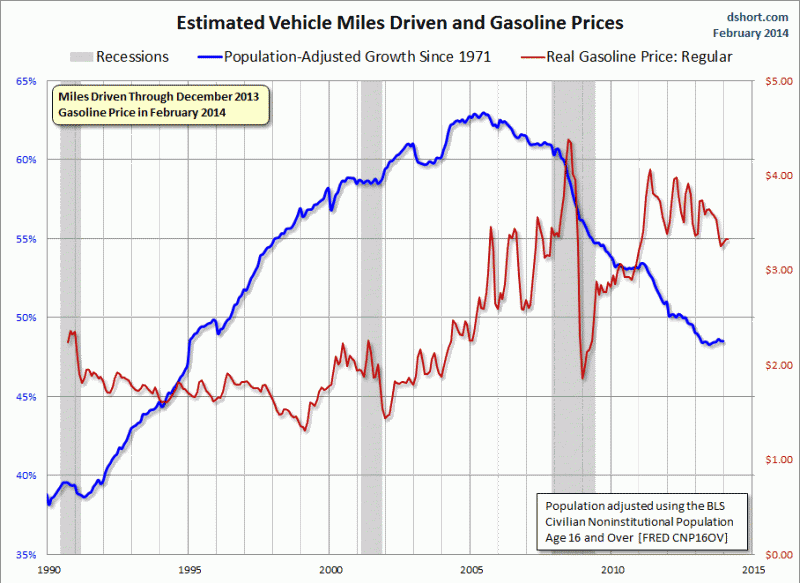Miles Driven, Update and Prediction
I just skipped over to one of Doug Short's constantly updating sites and checked out the graph of recent numbers concerning how much per capita we in the US are driving. Given the paramount importance over road travel is in these paved states, it's a good indicator of economic health generally, at least as a snapshot. The latest graph:

As you can see, things have leveled off lately; 2013 was a plateau year, it seems, with driving almost maintaining its level (varying only a fraction of a percent throughout the year). That might have something to do with the price of gasoline that year:

Check out the variation in price for 2013; a big spike in the first months, followed by a steady decline. Quite a difference from the "M"-shaped price roller coaster of 2012, wouldn't you say? 2013 looked like a much better year price-wise, probably leading to a calming of fears, which might just have led to folks worrying about the price of gas, which might just have led to folks focusing less on fuel efficiency in their new car purchases and where they live relative to the destinations to which they regularly travel. In other words, without major spikes in price, people worry about reducing their driving less.
Ah, but I've been noticing in just the last few weeks what the price has been doing. Have you? Here in the Pacific Northwest, I've seen a spike of over 30¢ a gallon, and it's still creeping upward. Notice that little tick upward in the price before January. This means the price is starting another spike. Which leads to my prediction:
The next per capita miles driven graph will show
a reduction in miles driven from the "8.87% from peak."
I don't know how much of a reduction there will be. I don't know how far the price of gas will rise, and even if I did I don't know how much that price spike is in real dollars adjusted for inflation. I just know that the 10% increase in prices in just the last few weeks is bound to affect driving habits downward.
I'm thinking about all of this just as "Nasa's Goddard Space Flight Center has highlighted the prospect that global industrial civilisation could collapse in coming decades due to unsustainable resource exploitation and increasingly unequal wealth distribution," according to a new study.
Noting that warnings of 'collapse' are often seen to be fringe or controversial, the study attempts to make sense of compelling historical data showing that "the process of rise-and-collapse is actually a recurrent cycle found throughout history." Cases of severe civilisational disruption due to "precipitous collapse - often lasting centuries - have been quite common."
With the Mayans, it was in their difficulty increasing their corn harvest in the 13th century; with the Romans, it was the limits of their expansion into conquered territories and an increasing reliance on Egypt providing an ever-increasing supply of the bread part of the "bread and circus" model that kept the little people happy. This latest study notes that, for most of our growing history, we, too, have increased consumption to maintain our lifestyles:
Technological change can raise the efficiency of resource use, but it also tends to raise both per capita resource consumption and the scale of resource extraction, so that, absent policy effects, the increases in consumption often compensate for the increased efficiency of resource use.
I know, I know; I'm about to subject myself to a hand-waving fest of "but fracking! You've forgotten fracking!" And how that will increase the fuel supply and save the day. No, folks, I have not forgotten fracking. I am thinking very carefully about fracking, and about how it is proving to everyone but the mainstream media and other vested interests just another promise that is failing to deliver:
For the last three or four years, accordingly, the fracking bubble has been the most common item brandished by practitioners of peak oil denial as evidence that petroleum production can too keep on increasing forever, so there! . . .
The problem with this fond fantasy is that the numbers don’t even begin to add up. The latest figures . . . show just how bad the situation has become. Each year, on average, the oil industry has had had to increase its investments by 10% over the previous year to get the same amount of oil out of the ground. . . . As a result, oil companies around the world are cutting back on capital investment and selling off assets. That’s not the behavior of an industry poised on the brink of a new age of abundance; it’s the behavior of an industry that has just slammed face first into hard supply limits and is backing away groggily from the impact site while trying to stanch the bleeding from deep fiscal cuts.
(Oh, did I emphasize or what!?!)
The lesson: technological possibility is not the benchmark by which all gizmos and promises should be evaluated; financial viability is the prime metric. Which is why I noted a prediction in this pile of screen words. Predictions do one thing: they put money where the typing fingers tap. I'm not a betting person, but I think my model of reality is strong enough to stand a test. If we revisit Doug Short's site next month and find per capita driving has increased, then I was wrong, and will have to seriously reconsider my model of reality. I don't think I will be, but the possibility exists.
I think we're in the throws of a financial reality check. We have in our recent past replaced human and animal labor with mechanized labor, and the fuel to power those machines is running shorter than our demand for them to keep running. We are, as a result, driving less, but still splashing about in denial loudly enough to attract the crocodiles of reality. How long can this continue? "If something cannot go on forever," as economist Herbert Stein noted, "it will stop."
X-Posted to talk_politics.

As you can see, things have leveled off lately; 2013 was a plateau year, it seems, with driving almost maintaining its level (varying only a fraction of a percent throughout the year). That might have something to do with the price of gasoline that year:

Check out the variation in price for 2013; a big spike in the first months, followed by a steady decline. Quite a difference from the "M"-shaped price roller coaster of 2012, wouldn't you say? 2013 looked like a much better year price-wise, probably leading to a calming of fears, which might just have led to folks worrying about the price of gas, which might just have led to folks focusing less on fuel efficiency in their new car purchases and where they live relative to the destinations to which they regularly travel. In other words, without major spikes in price, people worry about reducing their driving less.
Ah, but I've been noticing in just the last few weeks what the price has been doing. Have you? Here in the Pacific Northwest, I've seen a spike of over 30¢ a gallon, and it's still creeping upward. Notice that little tick upward in the price before January. This means the price is starting another spike. Which leads to my prediction:
The next per capita miles driven graph will show
a reduction in miles driven from the "8.87% from peak."
I don't know how much of a reduction there will be. I don't know how far the price of gas will rise, and even if I did I don't know how much that price spike is in real dollars adjusted for inflation. I just know that the 10% increase in prices in just the last few weeks is bound to affect driving habits downward.
I'm thinking about all of this just as "Nasa's Goddard Space Flight Center has highlighted the prospect that global industrial civilisation could collapse in coming decades due to unsustainable resource exploitation and increasingly unequal wealth distribution," according to a new study.
Noting that warnings of 'collapse' are often seen to be fringe or controversial, the study attempts to make sense of compelling historical data showing that "the process of rise-and-collapse is actually a recurrent cycle found throughout history." Cases of severe civilisational disruption due to "precipitous collapse - often lasting centuries - have been quite common."
With the Mayans, it was in their difficulty increasing their corn harvest in the 13th century; with the Romans, it was the limits of their expansion into conquered territories and an increasing reliance on Egypt providing an ever-increasing supply of the bread part of the "bread and circus" model that kept the little people happy. This latest study notes that, for most of our growing history, we, too, have increased consumption to maintain our lifestyles:
Technological change can raise the efficiency of resource use, but it also tends to raise both per capita resource consumption and the scale of resource extraction, so that, absent policy effects, the increases in consumption often compensate for the increased efficiency of resource use.
I know, I know; I'm about to subject myself to a hand-waving fest of "but fracking! You've forgotten fracking!" And how that will increase the fuel supply and save the day. No, folks, I have not forgotten fracking. I am thinking very carefully about fracking, and about how it is proving to everyone but the mainstream media and other vested interests just another promise that is failing to deliver:
For the last three or four years, accordingly, the fracking bubble has been the most common item brandished by practitioners of peak oil denial as evidence that petroleum production can too keep on increasing forever, so there! . . .
The problem with this fond fantasy is that the numbers don’t even begin to add up. The latest figures . . . show just how bad the situation has become. Each year, on average, the oil industry has had had to increase its investments by 10% over the previous year to get the same amount of oil out of the ground. . . . As a result, oil companies around the world are cutting back on capital investment and selling off assets. That’s not the behavior of an industry poised on the brink of a new age of abundance; it’s the behavior of an industry that has just slammed face first into hard supply limits and is backing away groggily from the impact site while trying to stanch the bleeding from deep fiscal cuts.
(Oh, did I emphasize or what!?!)
The lesson: technological possibility is not the benchmark by which all gizmos and promises should be evaluated; financial viability is the prime metric. Which is why I noted a prediction in this pile of screen words. Predictions do one thing: they put money where the typing fingers tap. I'm not a betting person, but I think my model of reality is strong enough to stand a test. If we revisit Doug Short's site next month and find per capita driving has increased, then I was wrong, and will have to seriously reconsider my model of reality. I don't think I will be, but the possibility exists.
I think we're in the throws of a financial reality check. We have in our recent past replaced human and animal labor with mechanized labor, and the fuel to power those machines is running shorter than our demand for them to keep running. We are, as a result, driving less, but still splashing about in denial loudly enough to attract the crocodiles of reality. How long can this continue? "If something cannot go on forever," as economist Herbert Stein noted, "it will stop."
X-Posted to talk_politics.